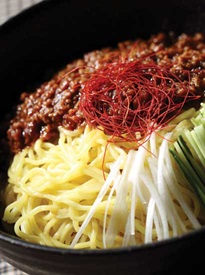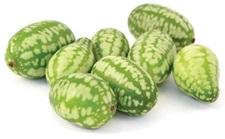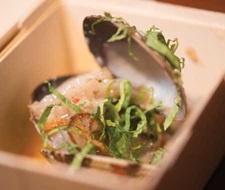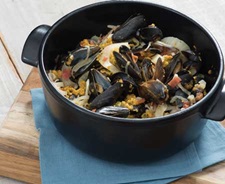Travel the Globe One Ingredient at a Time
INGREDIENTS

The next best thing to visiting a global locale is being able to enjoy the flavors and foods of that place’s cuisine from the comfort of your home. Chefs and product developers are drawing from the global pantry and experimenting with spices, chili peppers, fruits, vegetables, and more sourced from around the world to create globally inspired packaged goods and foodservice fare. Ingredient innovators like Sensient Flavors are also exploring world cuisines. The company in June released five savory snack concepts—Filipino Adobo Potato Chips, Vietnamese Pho Peanuts, Cuban Mojo Popcorn, Nordic Sour Cream, Lemon & Dill Potato Chips, and North African Spice Chickpeas—that capture key flavors of these cuisines. McCormick & Co.’s 2017 Flavor Forecast report highlights global tastes with featured dishes such as congee, cured yolk, and shakshuka, and ingredients like espelette pepper, baharat seasoning, and barberries. Calling this activity “post-regional,” Kara Nielsen, sales and engagement manager USA for Innova Market Insights, says that today’s chefs and consumers are excited about everything when it comes to food and are willing to try new foods and flavors. “It’s a sign of maturity in this exciting food culture that we have.”
The number of global food product offerings in grocery stores and supermarkets continues to grow. Since 2014, the number of new global food and beverage launches with what Innova calls an ethnic positioning has increased two-and-a-half times, says Nielsen. Asian flavors are a big part of this; data from Innova presented at the IFT17 food expo showed that from 2015 to 2016, the percent growth for new products with Korean flavors was 46%, with Thai at 40%, Japanese at 32%, and Chinese at 19%. Whether it’s Asian or another cuisine, consumers want authenticity. From 2011 to 2016, there was a 15% compound annual growth rate for new food and beverage products with an “authentic” claim, according to data from Innova.
In addition to the post-regional approach to food development, there is a hyper-specific approach, says Nielsen. By this she means taking things to a singular, specialty level such as foodservice operations that focus on one or two main dishes. Examples include poke bowl restaurants that are opening up in many cities around the country and Chick ‘n Rice, a counter-service restaurant that specializes in khao man gai, a Thai version of chicken and rice. What’s great about establishments like these, says Nielsen, is that they can introduce newcomers to a cuisine, and that may eventually lead to a deeper understanding of it.
Travel the world with Food Technology magazine as this month’s Ingredients column looks at how global cuisines and ingredients are evolving and what is emerging, with insights provided by chefs, ingredient developers, food marketers, and food trend experts.
Emphasizing Regionality
As interest in global cuisines increases, with some consumers becoming more adventurous with their food choices, product developers and chefs are moving beyond typical fare (think egg rolls, burritos, and sauces simply labeled “mild,” “medium,” and “hot”) to offer products and dishes that reflect the regional nuances of global cuisines. Asian and Mexican cuisines are more popular than ever. Throughout the regions in Asia and Mexico are specific ingredients and cooking methods that chefs and product developers are exploring to give consumers the authenticity they now want.
“There is nothing hotter globally than Asian cuisine right now,” says Dax Schaefer, executive chef at Asenzya. “Because of years of Americanized Chinese restaurants, Americans are familiar with the main ingredients and ready for more authentic dishes. We love the culinary focus that Asia has on balancing flavor profiles such as sweet, savory, and spicy.”
 Four Asian cusines are currently on Schaefer’s radar. All four are bringing interesting elements into the mix. From Thai cuisine, keep an eye out for more curries, coconut, galangal, and Thai basil. Soups, crepes, and banh mi sandwiches are Vietnamese dishes finding their way onto restaurant menus and in cookbooks and food magazines while Japanese ingredients such as mirin, soy sauce, and miso are moving beyond Asian food and are being used to add pops of savory and umami tastes to soups, sauces, marinades, and more. Finally, Korean cuisine has helped to generate interest in fermented foods and ingredients such as kimchi and gochujang. Bulgogi, marinated grilled beef, has taken off in popularity thanks to the number of Korean barbecue restaurants that have opened in many cities around the United States. Korean barbecue is even a flavor on its own; spotted by Food Technology at this year’s National Confectioners Association Sweets & Snacks Expo and hitting grocery store shelves nationwide this fall are Potato Chips with “smoky and roasty-sweet hoisin and garlic notes.”
Four Asian cusines are currently on Schaefer’s radar. All four are bringing interesting elements into the mix. From Thai cuisine, keep an eye out for more curries, coconut, galangal, and Thai basil. Soups, crepes, and banh mi sandwiches are Vietnamese dishes finding their way onto restaurant menus and in cookbooks and food magazines while Japanese ingredients such as mirin, soy sauce, and miso are moving beyond Asian food and are being used to add pops of savory and umami tastes to soups, sauces, marinades, and more. Finally, Korean cuisine has helped to generate interest in fermented foods and ingredients such as kimchi and gochujang. Bulgogi, marinated grilled beef, has taken off in popularity thanks to the number of Korean barbecue restaurants that have opened in many cities around the United States. Korean barbecue is even a flavor on its own; spotted by Food Technology at this year’s National Confectioners Association Sweets & Snacks Expo and hitting grocery store shelves nationwide this fall are Potato Chips with “smoky and roasty-sweet hoisin and garlic notes.”
As with Asian food, consumers are learning more about the diverse range of ingredients and foods from regions across Mexico. “Twenty years ago, we looked at Mexican food as only ground beef tacos and a canned salsa,” says Schaefer. “Today, Mexican is no longer considered ethnic as much as comfort food. We see a growing taste for more authentic cuisine.” Certain ingredients like chili peppers characterize Mexican cuisine. “Americans are comfortable with many different types of peppers,” says Schaefer. “We don’t want to read ‘hot pepper’ on the menu, we want to know if it’s serrano, chipotle, habanero, or jalapeno.” Mole is a signature sauce in Mexican cuisine. There’s no set recipe for a mole; the recipes can differ not only region to region but town to town, and can contain any combination of ingredients such as chilis, spices, herbs, onion, garlic, nuts, seeds, and dried fruit. These complex sauces are becoming more popular, says Schaefer. “Americans are branching out further than just guacamole and look to the beautiful line of authentic Mexican sauces.”
 Speaking of sauces, one of the latest Trending Flavors reports from Asenzya details 10 top international hot sauces and includes some well-established ones like sriracha and sweet Thai chili sauce along with others, such as guilin sauce and tomato achaar, that are sought after by adventurous eaters. The other six sauces on the list are sambal oelek, harissa, peri-peri, gochujang, garlic chili sauce, and hot banana sauce. All the sauces promise to add layers of flavors, be they sweet, savory, umami, citrusy, fermented, or spicy, as well as varying levels of heat from mild to hot. Of the sauces on the list, Schaefer points to sambal oelek, harissa, and peri-peri as the ones that have the potential to break through to the mainstream like sriracha has done and to achaar and gochujang as those that may remain on the fringe only to be enjoyed among certain consumers who seek out unusual ingredients. He says that sambal oelek has a very approachable flavor profile, good heat, and nice sweet level and is found on the dining tables in many Asian restaurants, where it is used as a condiment. “Americans love Asian flavor profiles, and this one is very comparable to sriracha in many aspects.” Harissa is popular in North Africa, so popular that Schaefer says it is often referred to as the “African ketchup.” This sauce’s flavor profile is complex, with notes of garlic, citrus, herbs, and brown spice. Peri-peri is another sauce that Schaefer believes can become a mainstream condiment since it has strong citrus notes and works quite well as a marinade for pork and chicken. As for those on the fringe, tomato achaar and gochujang have a little way to go before being widely accepted. Tomato achaar, a thick sauce with the flavors of roasted tomato, hot chili peppers, ginger, and brown spice notes, has its origins in India and Nepal. “Indian food still struggles to gain a foothold in American society. While there are amazing flavor profiles, it is still not hitting the mark like we thought it would a few years back,” says Schaefer. Gochujang comes to us by way of South Korea, where it is often used in kimchi, bibimbap, and lettuce wraps. It has some level of heat and fermented, “funky” flavors. “The flavor is amazing and complex; however, it has a difficult name for most Americans to remember. Also, it is more of an ingredient than a condiment, so you have to commit your whole meal versus a bite or two to try it.”
Speaking of sauces, one of the latest Trending Flavors reports from Asenzya details 10 top international hot sauces and includes some well-established ones like sriracha and sweet Thai chili sauce along with others, such as guilin sauce and tomato achaar, that are sought after by adventurous eaters. The other six sauces on the list are sambal oelek, harissa, peri-peri, gochujang, garlic chili sauce, and hot banana sauce. All the sauces promise to add layers of flavors, be they sweet, savory, umami, citrusy, fermented, or spicy, as well as varying levels of heat from mild to hot. Of the sauces on the list, Schaefer points to sambal oelek, harissa, and peri-peri as the ones that have the potential to break through to the mainstream like sriracha has done and to achaar and gochujang as those that may remain on the fringe only to be enjoyed among certain consumers who seek out unusual ingredients. He says that sambal oelek has a very approachable flavor profile, good heat, and nice sweet level and is found on the dining tables in many Asian restaurants, where it is used as a condiment. “Americans love Asian flavor profiles, and this one is very comparable to sriracha in many aspects.” Harissa is popular in North Africa, so popular that Schaefer says it is often referred to as the “African ketchup.” This sauce’s flavor profile is complex, with notes of garlic, citrus, herbs, and brown spice. Peri-peri is another sauce that Schaefer believes can become a mainstream condiment since it has strong citrus notes and works quite well as a marinade for pork and chicken. As for those on the fringe, tomato achaar and gochujang have a little way to go before being widely accepted. Tomato achaar, a thick sauce with the flavors of roasted tomato, hot chili peppers, ginger, and brown spice notes, has its origins in India and Nepal. “Indian food still struggles to gain a foothold in American society. While there are amazing flavor profiles, it is still not hitting the mark like we thought it would a few years back,” says Schaefer. Gochujang comes to us by way of South Korea, where it is often used in kimchi, bibimbap, and lettuce wraps. It has some level of heat and fermented, “funky” flavors. “The flavor is amazing and complex; however, it has a difficult name for most Americans to remember. Also, it is more of an ingredient than a condiment, so you have to commit your whole meal versus a bite or two to try it.”
So, what’s a product developer to do to formulate products that both play up the global food trends while appealing to a wide swath of consumers, especially when, as Schaefer notes, many consumers say they want to try new foods but often balk when given something out of their comfort zone? His approach is to add a slight global twist to something that appeals to many consumers—formulating a pot roast with the flavors of Korean bulgogi, for example. “Many consumers look at pot roast as a comfort food they understand. Bulgogi sounds intimidating, but change its name to Korean barbecue and the addition of global flavors doesn’t feel as far out there. All of a sudden, a Korean barbecue pot roast is a safe customer exploration, something they can understand, will try, and enjoy.”
 New Takes on Tacos
New Takes on Tacos
Once a staple in Tex-Mex cuisine, the taco has gone gourmet. Chefs like Rick Bayless are serving up authentic tacos with fillings like pork cecina, chorizo, and beef tasajo topped with grilled chiles and onions, and the team members at San Francisco’s Tacolicious restaurant are preparing tacos like Baja-style Pacific cod, summer squash, corn, and poblano rajas, guajillo-braised beef, and mushroom carnitas. The taco concept itself has even become a format to introduce flavors and ingredients from other cuisines. The tacos at Roy Choi’s Kogi BBQ food truck are one of the most well-known examples of this taco combination. The Southern California–based chef combines the flavors of Korean cuisine in tacos like short rib (Korean barbecue short rib, salsa roja, and chili soy slaw), tofu (tofu marinated in chiles, garlic, and citrus, grilled, and then topped with salsa verde), and pork (pork belly, butt, and shoulder marinated in sweet and spicy gochujang).
Ingredient manufacturer Kerry introduced at IFT 17 its own global take on the taco with mini taco product concepts made with the company’s plant-based protein shreds and bulgogi sauce. “The inspiration for this concept included a growing interest in plant-based diets, the familiarity of a taco, and that ‘spicy’ flavors, including Korean bulgogi sauce, were trending,” says Cian Leahy, Kerry’s director of savory applications. A globally inspired product concept like this one also shows how clean label or healthful ingredients fit into product formulation efforts. “The taco concept provided an authentic and transparent taste experience. We wanted to minimize the ingredient statement while maximizing taste and nutrition. Kerry’s plant-based protein shreds have only seven ingredients and provide an excellent source of protein and fiber. The bulgogi sauce was formulated using insights from our colleagues in Asia, allowing us to deliver on an authentic taste.”
Some emerging trends related to global cuisines and ingredients include the rise in use of certain ingredients, including fermented products such as gochujang and kombucha, tamarind, and Middle Eastern and North African spice blends such as za’atar and dukka, and the popularity of Southeast Asian, Middle Eastern, and North African cuisines, says Leahy. He’s also noticed more consumers shifting to a flexitarian or plant-based diet to meet their daily protein needs. Think about this last point and it make sense; many dishes in these popular global cuisines feature meatless protein options like tofu, nuts, and beans.
Several factors play into consumers’ preferences for global cuisines and ingredients and the ways in which product developers formulate globally inspired food and beverage products. “Today’s consumer is demanding products that are authentic and transparent,” says Leahy. “The experience of eating is not just eating any longer. Consumers expect ‘food with a story’ on specific, global flavors, and ingredients. Delivering on an authentic taste experience is a combination of great taste, cultural accuracy, and transparent sourcing and is also one of the greatest challenges for product developers.” To deliver on authenticity, Leahy says that it’s important to understand what authenticity means to the target consumer in terms of recipe, ingredients, cooking process, and presentation of food. “At Kerry, our global reach provides us access to market insights and consumer trends that may be in their inception in the U.S., but ubiquitous in another region,” says Leahy. “We can call on the expertise of our colleagues in these regions so they can educate and provide samples of these foods to help us in development so we can ultimately deliver [to] our customer an authentic and consumer-accepted final product.”
Emerging Global Flavors
Finally, insights into flavors are on the horizon from a leading flavorings manufacturer. Some of the flavors on Sensient Flavors’ 2017 Trends to Taste list that have global reach are damiana, burnt miso caramel, and cucamelon. First up is a flavor with an East meets West characteristic to it—burnt miso caramel. Caramel is a favorite nostalgic ingredient, and miso, a fermented soybean paste, is an important component in Japanese cuisine. Combining the sweet, brown tastes of caramel with the dark soy and umami tastes of miso, burnt miso caramel flavor is a global twist on salted caramel.
Another notable flavor on the list is damiana, an herb that originated in Central America with a mellow chamomile fragrance and both a smooth buttery taste and a crisp taste of fresh green figs. “This ingredient, known for its influential properties in matters of the heart, was central to love spells throughout history and is actually still on the market in formats like a gratitude tea and love elixir kombucha,” says Lauren Williams, director of marketing, global sweet & beverage flavors, at Sensient Flavors. When translating this idea for product developers, she suggests that they not ignore the connection between food and mood. “Our mood influences the foods that we choose and vice versa. Connect with consumers on an emotional level. Share with them the ‘mood’ of your product or the desired effect it will have for them (relaxation, energy, etc.). I am not sure damiana is scientifically proven effective in making people fall in love, but sometimes the placebo effect is all that we are really looking for.”
 The cucamelon is, as Williams puts it, “a funny one.” “This cute, little vine fruit looks like a laboratory creation but has actually been around since the Aztecs.” It resembles a tiny watermelon and has a cucumber aroma and taste with a sour lime finish.
The cucamelon is, as Williams puts it, “a funny one.” “This cute, little vine fruit looks like a laboratory creation but has actually been around since the Aztecs.” It resembles a tiny watermelon and has a cucumber aroma and taste with a sour lime finish.
Williams also offers up her thoughts on trending global cuisines. Filipino cuisine is one, as is Middle Eastern/North African cuisine. “In an industry where commercialized food tends to follow foodservice trends, we can expect a rise of Philippine cuisine on our shelves. The Philippines have consistently been in the top four sources of foreign-born immigrants to the United States since the 1990s, and we have definitely seen restaurants popping up across the country offering everything from Filipino fast food, like Jolibee, to haute cuisine.” As far as Middle Eastern and North African cuisines are concerned, Williams says that she expects them to follow a similar evolutionary pattern as Asian cuisine. “As most people will recall, in the states we used to see all Asian cuisines lumped together into a single amalgamation of ‘Asian food’, but they actually have very distinct styles and ingredients like sushi, bibimbap, and pho. Similarly, rising interest, access, and exposure to Middle Eastern cuisine will open up opportunities for distinction.” Kurdish food, she says, is full of ingredients like honey, figs, pomegranates, and fresh herbs, which already have fans in the states. “Translation at an appropriate level of ‘exotic’ to meet consumers where they are and a tasty execution is all that it needs to become a trend.”
Next month’s Ingredients section will discuss cheese ingredients and ingredients used to manufacture cheese products.
World Cuisines Influence Casual Dining
Around the world, casual dining is evolving, giving chefs a new focus and consumers more food and dining choices than ever before. The Culinary Institute of America’s 19th Annual Worlds of Flavor conference held in April gathered chefs, food writers, and restaurateurs to share their insights on the state of casual dining around the world.
The rapidly changing landscape of casual dining is being shaped by the public’s embrace of world cuisine from Asia to the Mediterranean to Latin America, said Anne McBride, director of culinary programs and editorial strategic initiatives at the Culinary Institute of America. She also mentioned that casual dining features a chef-driven approach with a focus on flavor and on creativity. K. F. Seetoh, founder of Makansutra, operator of food courts in Singapore and Manila, and the keynote presenter, spoke about the chef-driven approach to casual dining by saying that he admires the chefs who return to their roots and defend their own culinary heritage.
Throughout the conference, attendees were reminded of the importance that culinary heritage and global influences have on the dining experience. Many of the chefs spoke about how they learned to embrace their culinary roots or how their travels around the world influenced their approaches to recipe development and cooking, allowing them to use the techniques that they learned to give new twists to food. Here are some key highlights.
• Asha Gomez has found a successful way to tell her story, that of an immigrant from Southern India who calls the American South home, through the delicious ingredients and foods from both regions. Just don’t call her food fusion. “My food is an evolution of who I am as a person and these amazing places that I’ve been fortunate enough to call home.” Her food celebrates the flavors of both homes. Case in point: her recipe for fried chicken. She marinades chicken in a herbaceous brine of ginger, garlic, serrano chilis, mint, cilantro, salt, and buttermilk, fries it, and finishes it with coconut oil drizzle and a sprinkle of chili powder. Where her mother would serve the chicken over rice pilaf, Gomez serves hers over a cardamom low country waffle with a spiced maple syrup.
• Alam Méndez is making traditional Oaxacan cuisine—with a twist—accessible to all. Like many chefs, Méndez’s culinary career took him to various places around the world, but he said that the more he learned outside of Mexico, the more he wanted to return and cook the food of his Oaxacan heritage, but with a more modern styling. At the food hall held each day of the event where chefs prepared tasting portions, Méndez served a tamale made with chepil, a key herb used in Oaxacan cooking; thin masa cakes called memelas topped with black mole, both of which are traditional Oaxacan fare; and a take on ceviche made with corn and chapulines (grasshoppers), a popular snack food in parts of Mexico, particularly Oaxaca.
 • At the end of the Vietnam War, many Vietnamese fled to Louisiana, mainly near New Orleans, bringing with them their culinary traditions. Born and raised in New Orleans, Michael Gulotta celebrates the flavorful ingredients and foods of both New Orleans and Vietnamese cuisine at his restaurant, MoPho. During a breakout seminar, he commented on the similarities between Southeast Asian and Southeast Louisiana cooking, one of which is dishes made with both shellfish and pork. His pepper jelly and coconut braised clam dish featured clams bathed in a broth made with aromatics, lemongrass, coconut milk, and pepper jelly garnished with shaved lardo.
• At the end of the Vietnam War, many Vietnamese fled to Louisiana, mainly near New Orleans, bringing with them their culinary traditions. Born and raised in New Orleans, Michael Gulotta celebrates the flavorful ingredients and foods of both New Orleans and Vietnamese cuisine at his restaurant, MoPho. During a breakout seminar, he commented on the similarities between Southeast Asian and Southeast Louisiana cooking, one of which is dishes made with both shellfish and pork. His pepper jelly and coconut braised clam dish featured clams bathed in a broth made with aromatics, lemongrass, coconut milk, and pepper jelly garnished with shaved lardo.
• J.J. Johnson, executive chef at Minton, wants people to discover rice for what it truly is—not the parboiled grain served as a side dish afterthought, but rather as a food with a rich history and an important role in cuisines and economies around the world. He’s made it his mission to educate people about the origins of heirloom rice grains such as glaberrima, a centuries-old rice originating in West Africa, and Chinese black tribute rice, which originally was reserved only for the emperors in ancient China.

New Global Herb Blends Boost Flavor
Culinary pastes and blends from SupHerb Farms span five continents and contain ingredients from and capture the flavors of key cuisines from around the world. More than three dozen (41 to be exact) make up the line; they include options like Creole, Herbes de Provence, North African Green Harissa, Thai Red Curry, Jamaican Jerk Seasoning, Indian Masala, Roasted Red Pepper Spread, and Chimichurri. The company in August added four new items to the line. Aji Pesto Paste blends cilantro, mild onion, and aji pepper for a sweet and slightly tangy paste, while the Tabbouleh Starter is an aromatic blend of herbs, tomatoes, green onions, and garlic. The other two new culinary pastes are Chermoula, a Moroccan sauce that combines cilantro, parsley, and garlic for mild tanginess and a slight kick of heat, and S’chug, a Middle Eastern hot sauce made from jalapenos, garlic, and herbs. All the SupHerb Farms Fusion Pastes and Blends have multiple uses in grain dishes, meat and seafood applications, salads, marinades, soups, stews, and rubs. Formulators of sauces, dressings, dips, and spreads can create some creative and distinctive products with the pastes and rubs. Try using Ginger Cilantro Sesame Paste in dressing, Indonesian Style Chili Paste in ketchup, or Mexican Ancho Chile with Lime Paste in sour cream or yogurt. Use Guacamole Starter Paste to formulate a traditional guacamole, or add unexpected flavors by blending Sun-Dried Tomato Chipotle Paste or Citrus Garlic Herb Paste into a traditional guacamole recipe. Creole Paste gives mustard additional layers of flavor and heat while Moroccan Harissa and North African Green Harissa take peanut butter to spicy new flavor levels.
Key Vegetables, Fruits for International Flair
It’s not uncommon anymore to find fruits and vegetables from around the world in grocery stores and available to chefs and product developers thanks to trade and improvements in logistics and agricultural practices. Passion fruit, guava, prickly pear, melon, and ginger are hits so far in 2017, says Dawn Merrill, technical services manager at Kerr Concentrates, who adds that culinary trends point to jicama becoming more popular, too. “Jicama, a tuber originating in South America and Mexico, often described as a cross between an apple and a potato, is popular as a snack, on top of salads or salsa, and can even be a substitute for water chestnuts. Here at Kerr Concentrates, we’ve produced Jicama Juice Concentrate, which is inherently sweet, but low in sugar and calories, making it the perfect sugar substitute in many applications.” Use it as a stand-alone ingredient or blend it with other ingredients to create both sweet and savory flavor profiles.
Add flavor twists to food and beverage products by combining fruits and vegetables with other global ingredients. “Pushing the boundaries of taste and flavor is becoming more important, especially now that consumers are becoming more adventurous with flavors and foods,” says Merrill. “For example, to create hot/cold sensations, we’re taking watermelon and blending this sweet and refreshingly cool puree with spicy habanero pepper for a subtle kick reminiscent of Mexican cuisine—think spicy agua fresca. For those consumers who dream of escaping to Central America, we have passion fruit blends. Passion fruit pairs remarkably well with some of the more mainstream berries like strawberry, raspberry, and even stone fruits like peach. We’re working with savory blends and adding spices to our fruit and vegetable lineup to entice global customers.”
www.ift.org
Members Only: Read more about global cuisines and ingredients at ift.org. Type the keywords into the search box at the upper right side of the home page.
 Karen Nachay,
Karen Nachay,
Senior Associate Editor
[email protected]
